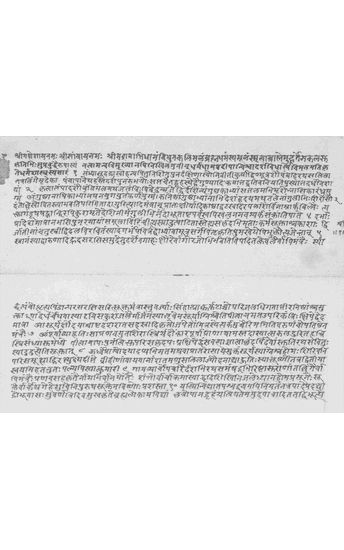Note: The Original Era for the manuscripts has been converted to the English Calendar equivalent for retrieval purpose. The Original Era of the manuscript can be viewed in the Item View of each manuscript.*
विश्र्वादर्श of कविकान्तसरस्वती.
| Resource Type | : | Manuscript |
| Subject | : | Nibandhas |
| Script | : | Devanagari Handwriting |
| Notes/Description | : | Vis’vadars'a is a work on Dharma in four chapters, composed by Kavikantasarasvati, son ofAditya, described as “well-versed in the meaning of Gita. The author was patronised by a prince called Dhanyaraja, son of Nagarjuna. Our author alludes to Vijnanes'vara, author of the Mitaksara, which, he says, has immortalised the fames of the great king (Mahato Mahibhartuh;Vrddhabhartuh; see below). The earliest writer who quotes our author is Hemadri in Caturvargacintamani, Paris’esakhanda, pt. 2,p. 112 (see below). Vis’vadars’a was also used in the composition of his Kaladars’a by Adityabhatta.Kaladars’a again is quoted in Kalamadhava; see I. O., No. 1655. The manner in which our author refers to Vijnanes’vara shows that he was separated from him at least by a hundred years.Our author, therefore must have flourished towards the close of the 12th or the beginning of the 13th century.Our MS. is incomplete. It runs upto v. 21 of the third Kanda. There are however, three good MSS. of the Vis’vadars’a in the Bhadakamakara Memorial Collection of MSS. (see above under No. 572). Two of these contain all the four Kandas, while the third contains only three like the MSS. noticed at C. C. 1 p. 586. The fourth Kanda was not usually copied out as it treats of Philosophy rather than Dharma. Our author was a follower of the Advaita school of the Vedanta and a pious devotee of Rama and Vis’ves’vara of Benares. His patronDhanyaraja was very probably a ruling prince of Benares.The first Kanda treats of Sadacara in 43 s’lokas in the S'ragdhara metre (except v. 40 which is in Anustubha ). The second treats of Vyavahara in 44 s’lokas. In this Kanda, the Anustubh metre is used for all even s’lokas except the last; Malini for all odd s’lokas upto the 19th; thereafter Mandakranta upto the 35th;and after this S’ardulavikridita upto the end.The last verse is also in the S’ardulavikridita.The third Kanda treats of the Prayas’cittas in 50 s’lokas, 49 of which are written in the Sragdhara metre, Malini being used for the last.In the fourth Kanda, the first s’loka is a Giti; then follow alternately S'ardulavikridita and Anustubh s’lokas upto v. 37; v. 38 is a S’ikharini then again follow in alternate succession Anustubhs and S’ikharinis upto v. 47; v. 48 is a S’ardulavikridita; 49 and 51 are Anustubhs; 50 and 52 are S’ikharinis and the last i. e. 53rd is a S’ardulavikridita.Our author mostly follows Yajnavalkya in the order of topics, and usually agrees with Vijnanes’vara in the interpretation of the Smrti texts. For this same opinion, cf. Mitaksara on II. 124. So also, the opinion of Mitaksara on II. 118-119 is embodied in the following verse:—The twelve kinds of sons are not at all discussed by our author, though the Aurasa sons from the wives of different castes are mentioned:— Regarding the order of succession, our author says :— In the present MS. Kanda I contains 42 s’lokas while Kanda II has 46. The description of the work given above is based on one of the B. M. C.MSS. mentioned above. The other two B. M. C.MSS., however, are very important since they contain the author’s own commentary on the text.This commentary begins :— As explained by the author himself in the commentary, Vis'vadars'a is based upon the following Smrtis. Also the following Puranas and Nibandhakaras are referred to :— On I, 4, the commentator remarks:— At the end of the commentary on III. 33, the following verse is found :— The usual colophon of the commentary is:— As regards the quotation in Hemadri, it occurs in the commentary on III. 37. |
| Pages/Folios | : | Folios: 9 , Lines: 10 , Folio Size in Inches: 10.5 x 4.25 |
| Identifier | : | MS_00000720 |
| Digitization Sponsor | : | Government of Maharashtra |
